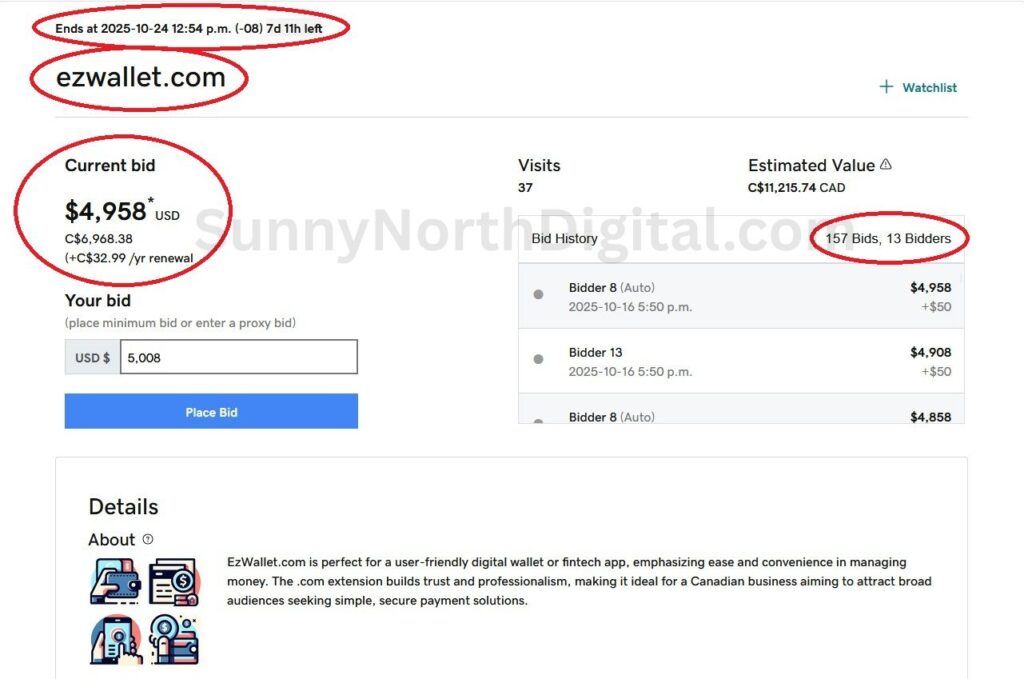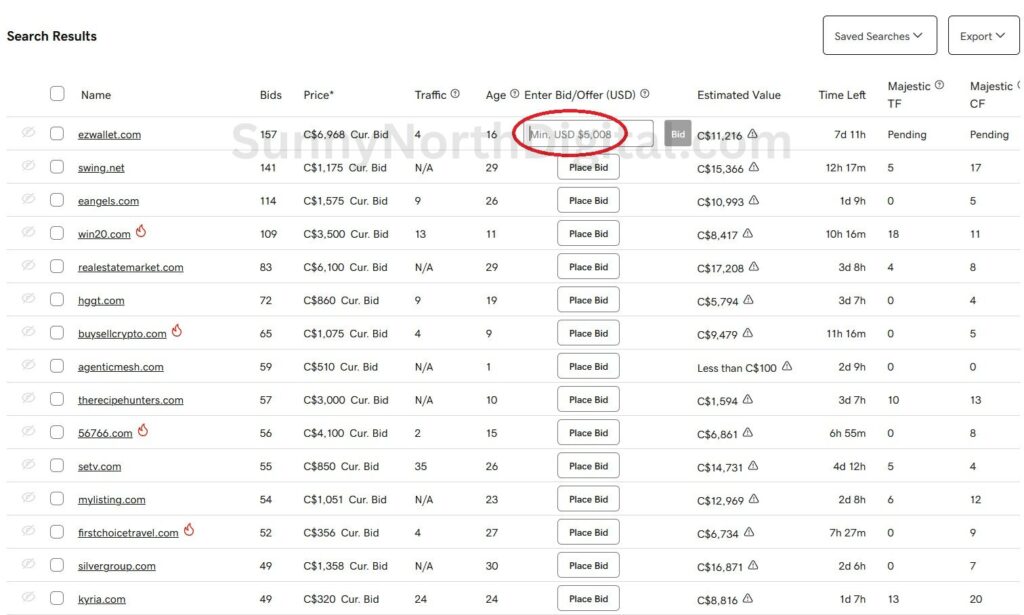How to Win a Domain Auction: 7 Bidding Strategies for Beginners (2026)

You’ve found the perfect expired domain using your search checklist. You’ve done your homework and valued the domain.
The auction countdown timer is ticking… 1 hour left. What do you do now?
Bidding in a domain auction can be a nerve-wracking experience. Bid too early, and you drive up the price. Bid too late, and you might miss out. The key isn’t emotion; it’s strategy.
In this guide, I’ll break down the 7 key domain bidding strategies professionals use, from understanding proxy bidding to last-minute sniping.
These domain auction tips will help you enter your next auction with a clear plan and the confidence to win without overpaying.
The Golden Rule: Set Your Maximum Bid and Stick to It
Before we even discuss bidding tactics, this is the non-negotiable first step. How much to bid on an expired domain should be determined before the auction even starts.
Use the valuation techniques you learned in my guide to determining a domain’s true value to set a firm “walk-away” price based on your research and potential ROI.
Write this number down. This is your anchor; without it, you risk getting caught in a bidding war and drastically overpaying.
Understanding the GoDaddy Auction Process (The Basics)
While strategies apply across platforms, we’ll use GoDaddy Auctions as our main example since it’s one of the most popular domain auction marketplaces. Most standard GoDaddy auctions run for 7 days.

A key feature to understand is “extended bidding”: if a bid is placed within the last few minutes, the auction is often extended, preventing last-second “sniping” from automatically winning.
Familiarize yourself with the specific rules of the platform you’re using.
7 Domain Bidding Strategies for Beginners
Here are the most common approaches, along with their pros and cons.
Strategy #1: The Early Bid (Setting the Tone)
- What it is: Placing a bid early in the auction, often just slightly above the minimum.
- Pros: Establishes you as an interested bidder, can sometimes deter casual competitors.
- Cons: Often just encourages others to bid against you, potentially driving the price up unnecessarily early. Rarely the winning strategy.
Strategy #2: The Incremental Bidder (Staying in the Game)
- What it is: Placing small, incremental bids throughout the auction whenever you are outbid, staying just ahead of the competition.
- Pros: Keeps you actively involved and ensures you’re always the current high bidder (until someone else bids).
- Cons: Can easily lead to emotional bidding and exceeding your maximum price. It also signals your strong interest to competitors.
Strategy #3: Proxy Bidding (The Professional’s “Set It and Forget It” Method)
Of all the bidding strategies, understanding proxy bidding is the most critical for success on platforms like GoDaddy Auctions. It is the most powerful tool for beginners to bid rationally and avoid overpaying.
What It Is: Proxy bidding is the auction platform’s built-in, automatic bidding system. Instead of placing incremental bids manually, you secretly tell the system the absolute maximum amount you are willing to pay for a domain.
How It Actually Works on GoDaddy: Many beginners are confused because there is no special “proxy bid” button. The way it works is simple: you just enter your maximum bid into the standard bidding box. The system then acts as your personal bidding agent.
- Example: The current bid on a domain is $50. You decide the domain is worth a maximum of $200 to you. You enter
$200as your bid. The system does not immediately jump the price to $200. Instead, it will automatically place a bid for the lowest possible amount to make you the new leader, based on the bid increment rules (which we’ll cover next). In this case, it might bid $55.
If another person bids $60, your proxy will instantly and automatically outbid them at $65. This continues until other bidders either give up or your secret maximum of $200 is reached.
Crucial Warning: According to GoDaddy’s terms, placing a proxy bid is binding and cannot be cancelled. This is why setting your maximum based on solid research is so important.

Pro Tip: Understand the Bid Increment Rules
The amount your bid increases isn’t random. It follows a set of “bid increment rules” that you need to know.
- For bids between $5 – $499, the next minimum bid is $5 higher.
- For bids between $500 – $999, the increment increases to $10.
- For bids of $1,000 or more, the increment is $25, and it continues to go up from there.
Knowing these increments helps you understand how quickly an auction’s price can rise and how your proxy bid will behave.
Watch Out for Extended Bidding!
Another critical rule to understand is that GoDaddy auctions have an “extension” feature.
If a bid is placed within the final few minutes of the auction, the timer is automatically extended. This is specifically designed to prevent “sniping” (placing a winning bid in the last second).
This is why the patient, “set it and forget it” proxy bidding strategy is often superior to trying to time your bids perfectly.
Pros:
- Excellent for beginners: It is the single best way to avoid emotional bidding and stick to your budget.
- It’s efficient: You don’t have to watch the auction for days on end. You can set your max bid and walk away.
- It keeps your strategy private: Competitors won’t know your true maximum price until it’s been met.
Cons:
- Requires discipline: Its effectiveness depends entirely on your ability to do your research and set an accurate maximum bid beforehand.
- Your bid is binding: Once you set a proxy bid, you cannot retract it, even if you change your mind.
Strategy #4: Last-Minute Bidding (“Sniping”)
- What it is: Placing your bid within the final seconds or minutes of the auction, hoping others won’t have time to react. This is often called domain auction sniping.
- Pros: Can sometimes win auctions at a lower price if competitors aren’t actively watching.
- Cons: Very risky due to extended bidding rules. You might miss placing your bid due to internet lag or simply be outbid immediately. Not recommended as a primary strategy for beginners.
Strategy #5: The Backorder as Your First Bid
- What it is: When you place a backorder on a domain before it drops, that backorder often acts as your opening bid if the domain goes to auction.
- Pros: Ensures you’re in the running from the very start for a domain you really want.
- Cons: Only applies if you successfully catch the domain via backorder.
Strategy #6: Look for “Buy Now” Opportunities
- What it is: Sometimes sellers list domains with a fixed “Buy Now” price alongside the auction.
- Pros: If the price is within your budget and valuation, you can bypass the auction entirely.
- Cons: “Buy Now” prices are often higher than what the domain might sell for at auction.
Strategy #7: The Psychological Bid (A Small Edge)
- What it is: Instead of bidding round numbers (like $100), bid slightly above (like $101 or $102.50).
- Pros: Can sometimes psychologically deter an opponent who was only willing to go up to the round number. It’s a minor tactic but can occasionally make a difference.
- Cons: Doesn’t overcome a determined bidder with a higher maximum.
Auction Psychology: Don’t Let FOMO Win
One of the biggest common domain bidding mistakes is letting emotions take over. The “Fear Of Missing Out” (FOMO) is powerful in auctions. You see others bidding, the timer is counting down, and you feel pressure to just bid a little bit higher… and then a little more. This is how you overpay.
Remember the Golden Rule: You set your maximum bid based on research and data before the auction started. Stick to it. There will always be another domain.
Winning an auction by overpaying is actually losing. Learning how to manage emotions in domain auctions is as important as any bidding tactic.
Your First Win is Just a Strategy Away
Winning a domain auction isn’t about having the deepest pockets; it’s about having the smartest strategy. Now that you understand these bidding tips and how to set your maximum price based on solid research, you’re ready to acquire your first valuable digital asset.
But winning the auction is just the beginning. The next crucial step is securing your new domain. To guide you through that process, I’ve created an essential post-acquisition checklist.
P.S. If any of the domain investing terms used in this guide were confusing, my comprehensive glossary is the perfect resource to get you up to speed.